
Wine Culture and Information since 2002 - Volume 22
 Wine Culture and Information since 2002 - Volume 22 |
|
Issue 105, March 2012 |
Contents |
|
|
Italy DOC |
|
When I started working in the world of wine - it was 1997 - Italy's Denominazione d'Origine Controllata e Garantita (DOCG) were 18. It was easy to remember them: after all, memorizing 18 names of areas or wines was a very simple task. Today, in a frosty and snowy day of February 2012, the number is 74. In just 15 years, the Olympus of Italian high quality enology has welcomed 56 new gods appreciated by Bacchus. With the exception of Vallée d'Aoste, Trentino-Alto Adige, Liguria, Molise and Calabria, every Italian region can proudly show off at least one DOCG wine; Tuscany, Veneto and Piedmont can even count 11, 14 and 16 DOCGs respectively. Not to mention Denominazione d'Origine Controllata (DOC) wines that - as of today - reached the remarkable number of 344. To them are added the wines occupying the lowest level of the Italian quality system - the so called Indicazione Geografica Tipica (IGT) - of which we can count a number of 120. Quick calculation: the number of Italian wines belonging to a legally recognized appellation is equal to 538. These figures can be easily obtained from the site of Italian Ministry of Food, Agricultural and Forest Politics - the official source for Italy - in which the list is updated to November 2011, integrated by news subsequent to this date. It should be thought, for example, six years ago - in 2006 - the amount of wines belonging to Italian appellations were about 350. The increasing in the course of the years is, like to say, amazing. The quality of Italian wines certainly is increased in the course of the last 15 years - there is no doubt about this - and it is normal, we could also say wished, this increasing should be certified and recognized with specific denominations. Italy is a country with a very long and undeniable wine making history, culture and tradition, and every region, every province, every municipality have countless wines, sometimes flaunted as historical and traditional, sometimes created in order to take advantage of a simple speculation. Asserting, for example, the long tradition and history of an Italian wine produced with Merlot, Cabernet Sauvignon or Chardonnay, frankly speaking, leaves us puzzled as well as astonished. After all, a denomination does not certify the tradition and the culture of a wine or a place, in theory, it just certifies its origin. It certifies the production area of a wine and that it was produced by following the rules set by law in the denomination itself, including grapes, wine making and aging techniques. The only exception is about the denominations having the “classico” rank, used to identify an area in which a wine is historically produced. Seeing in “classic” wines the intrusion of international grapes, leaves us perplexed anyway, both about its history as well as its typicality. Moreover, cases like those can cause legitimate doubts about the real purpose of denominations and the reason why, in Italy, there are so many. There are many who believe denominations are essential for the safeguarding of a product, they allow the construction of a better identity, give better commercial chances, lower the risk of deplorable forgeries. These points - in my opinion - are all debatable. Such a high number of denominations significantly contributes to cause confusion among consumers, who frequently do not consider denominations at all and buy wines according to other criteria. Sometimes, but we should say frequently, they even ignore the existence of many denominations. Such a high number of denominations obfuscates the Italian wine offer also and in particular abroad. If in Italy there are few who can recall the name of some tens of denominations of our Country, abroad they hardly known the name of two DOCG wines and their existence. If we consider communication, as a consequence of the huge confusion caused by the legitimate promotional activities every denomination do, the consumer is bewildered, overwhelmed by a loud “noise”. According to a commercial point of view, it is hard to understand the reason why sometimes certain DOC wines, and sometimes DOCG wines too, are sold for few euros, when it is evident those prices are lower than production and distribution costs. Price does not always make quality, of course: an expensive wine is not always better than a cheap wine. Moreover, forgery is not certainly avoided by a denomination: this is witnessed by the many wines produced with the clear intention of taking advantage of the success of others. Every law has a loophole. Nevertheless in Italy they are continuously trying to have a denomination for their wines: everyone wants a denomination, everyone struggles in order to reach DOCG, by using all the political power they have in order to reach the sought-after goal. The results of this race, unfortunately, are evident to everyone, better to say, in the everyone's glass. A race ending - most of the times - to give disappointing, depressing and improbable wines even though they belong to a denomination, wines that, in the best cases, have a modest, very modest, quality. Without mentioning any wine in particular, there are many DOC wines, as well as DOCG, that when you pour them in a glass, they leave you perplexed about their value and the quality they should represent - as a matter of fact - the highest expression of Italian enology. Moreover, disconcerting differences can be found also in wines belonging to the same denomination, wines that, in theory, should benefit of the same environmental and wine making conditions. Nevertheless, the results are so different one from each other that you can hardly believe it is the same wine, qualitative expression of the same territory. Producers, for better or worse, do their part, there is no doubt about this. I believe these considerations can be agreed by considering facts: how can it be possible institutions deciding and then controlling denominations do not realize that? How can it be possible they do not realize the huge damage the fragmentation of hundred of denominations causes to the image of Italian wine making, not only to its identity, but also to its quality? I am afraid they don't and, maybe, they are not even interested in considering the effects of this situation. It seems the most important thing is having a denomination: all the rest does not count. Not even wine. Antonello Biancalana
|
||||
Role of Yeast in TastingYeast is not only responsible for the fermentation of must transforming it into wine, it also strongly affects its organoleptic qualities |
|
The subject of natural wines certainly is among the most trendy ones in the world of the beverage of Bacchus. It is very debated, sometimes talking nonsense, fighting ridiculous ideological wars, there are factions of wine lovers and taster who will not have a wine in case it does not have the imprimatur in the label or in words it is a “natural wine”. What a natural wine is, as a matter of fact, no one can give an answer or define it clearly. In general terms - without any pretension of defining it - a natural wine is produced with the essential intervention of man, both in vineyard and in the winery, while limiting, or even avoid, the use of substance of chemical origin, by favoring - at the same time - natural practices and methods. Many forget, like to say, the only final and natural process about grape juice, even in case the intervention of man is limited to the essential, is to become vinegar. Allowing a must to ferment without interfering in any way - that is like “Nature” wants - means allowing bacteria and yeast to do the job Nature assigned to them, with the unavoidable result of making vinegar. Avoiding the development of vinegar during the production of wine requires the indispensable intervention of man who, by using technology and the control of chemical-biological processes, avoids the contamination and development of bacteria, as well as faults. The explicit goal - and certainly noble - of the production of natural wines is producing a beverage capable of expressing the potential and quality of a territory, considered as a whole of many and different factors. Among these elements, besides grapes, territory and micro climate, there is also yeast, sometimes a controversial element, naturally found in the air and which settles on the skin of grapes. Yeast, just like all the other living organisms and beings, fight a “war” for survival, with the result the most weak or minority organisms are being overwhelmed by the stronger species which become the dominant one. The same happens - as a matter of fact - during the fermentation of wine: an unrelenting struggle in which the stronger species win therefore becoming the dominant ones responsible for the effects of fermentation. Yeast, during fermentation, does not “demolish” sugar only, transforming it into ethyl alcohol and other substances, including carbon dioxide and sulfur dioxide. During fermentation, yeast, as a consequence of its activity, also gives wine specific organoleptic qualities, and can modify - even drastically - the olfactory and gustatory qualities of the beverage. The organoleptic qualities produced during fermentation are defined “secondary”, whereas the ones defined as “primary” are about the specific qualities of grapes and “tertiary” ones are about the result of the aging process. The role of yeast in the development of aromas in a wine is however fundamental and, it is not by chance, it is said primary aromas are hidden in the grape and it is the fermentation which reveals them”. Every kind and species of yeast, as well as bacteria, during their activity develop different aromas and flavors and not all the times these “organoleptic sensations” are considered positive for the wine.
The “colony” of yeast and bacteria getting in contact with the must and that will transform it into wine, is not easily determined, to be precise, is determined only by a specific laboratory analysis. On the skin of grapes are naturally present the very same yeast and bacteria found in the area where the vineyard is being cultivated. As the grape is crushed, essential operation in order to get the must, these yeast and bacteria get in contact with grape juice, therefore starting the fermentation process. Every yeast species, besides giving wine specific organoleptic qualities, also need proper conditions for its biological activity, among them, there is temperature. Thanks to the research on fermentation and on biological activity of yeast - research which had a fundamental contribution with the work of Louis Pasteur - the control of temperature during fermentation allows, as a matter of fact, the full activity of some yeast and the inhibition of others. The main yeast strain responsible for the fermentation of the must is the famous Saccharomyces Cerevisiae, the same used for the fermentation of beer. It is not the only yeast strain responsible for the production of wine, but - as a matter of fact - it is the one mainly favored during fermentation. This particular yeast is the same selected in laboratories for their so called “selected yeast”. Saccharomyces Cerevisiae is also found in the so called “indigenous yeast”, as well as other yeast and bacteria, not always useful for a stable and useful fermentation according to an enological point of view. Using the so called “indigenous yeast” or “autochthonous”, certainly means giving wine the “autochthonous” qualities of a place, but also taking the risk of developing a colony of unknown bacteria and yeast and not always producing a decent result. For this reason, producers who use the “indigenous” yeast - that is the one Nature and all the other environmental factors existing in their vineyard deposit on the skin of grapes - rarely take the risk of using it “as such”. Saved the case they are lucky of cultivating a vineyard in a territory blessed by the good fate of Mother Nature, in which are found “positive” yeast and bacteria for enological purposes, in general terms a sample of the indigenous yeast is sent to a laboratory in order to select it and to “get rid of” unwanted yeast and bacteria. It should also be said that in the winery is however worked a “natural” selection of the indigenous yeast during the control of fermentation. One of the most common natural techniques in winery is the control of fermentation temperature. This technique - which certainly is useful and accepted as essential in order to get a fine wine - as a matter or fact, works a fierce selection of the colony of yeast found in the must, while inhibiting the activity of the ones which cannot “live” at certain temperatures. It should also be noticed that the common technique of sanitizing the must before starting fermentation, by adding sulfur dioxide, works a preliminary selection of yeast. Sulfur dioxide literally poisons some strain of yeast, all considered negative for quality fermentation, a treatment to which survives the stronger and more resistant strains only. The rooms in which the fermentation takes place are naturally populated by yeast, not only the ones found in the air, but also the ones developed and multiplied during past fermentations. Also the yeast found in the winery will therefore pollute the must, by adding themselves to the ones already present, a phenomenon which can be considered as a further selection. The unavoidable consequence of these factors, besides technical and environmental conditions, is to work a selection on indigenous yeast. The final result is therefore strongly affected by the skill of the wine maker in controlling the fermentation process, as well as “living” in a privileged environmental context. Wine, of course, is not the simple result of fermentation done by yeast, it is however undeniable this fundamental process strongly affects the organoleptic qualities of the final product. In order to get positive organoleptic qualities from fermentation, although identifying a place and a terroir, it is however indispensable this process is scrupulously controlled. For this reason, many wine producers prefer using a selected yeast, capable of making fermentation more reliable, controllable and stable. The use of selected yeast also produces a specific and typical organoleptic result, therefore causing the unavoidable homologation of wine's organoleptic qualities. In other words, a wine produced with selected yeast can be easily recognized by a quick olfactory examination, as their aromatic characteristics are common to all the wines in which it has been used in fermentation. There are many types of selected yeast and laboratories producing it, frequently offer cultures and strains suited for the production of many types of wine. The main producers of selected yeast can offer strains suited for the production of white wines, aromatic white wines, red and rosé wines, sparkling and sweet wines, as to mention the most common cases. Every strain of yeast has specific qualities which are not only related to the specific organoleptic characteristic it will give to the wine. To better clear this concept, let's consider, for example, a sweet wine. One of the characteristics of these wines is the high alcohol by volume, frequently higher than 15%, therefore it is indispensable the yeast used for its fermentation can survive and “work” also with high quantities of alcohol. In these cases it is in fact preferred the use of Saccharomyces Bayanus, capable of tolerating a higher quantity of alcohol than the famous Saccharomyces Cerevisiae. Both the two yeast belong to the Saccharomyces genus, however they produce different fermentation results, by giving the wine specific organoleptic qualities. If it is true the organoleptic contribution of selected yeast is pretty predictable, the one of indigenous yeast is quite unpredictable. The unforeseeability of indigenous yeast - autochthonous or non selected - must however be considered both in a positive and negative way. In case the control of fermentation is not properly done, as well as in presence of a diversified and uncertain “colony” of yeast and bacteria, the result could be a wine with pretty poor organoleptic qualities, also characterized by evident faults. Moreover, the fermentation done with indigenous yeast can be considered as a sort of lottery: in case negative yeast and bacteria become dominant, the result will certainly be negative. By using the indigenous yeast, and in case the fermentation is mainly done by positive yeast for quality wine making, the final result will however and in any case be determined also by the organoleptic influence of the other minority yeast and bacteria. This does not mean the influence of other minority yeast and bacteria necessarily is negative: most of the times their contribution on wine's organoleptic qualities is absolutely positive, giving a greater complexity and sensorial diversification. The use of indigenous yeast certainly is more difficult than the selected one: this is the main reason for which most of producers prefer not to use it. Selected yeast ensures a quicker start of fermentation, a better control, higher stability, a higher warranty on the final result, including aromas and flavors. On the other hand, the huge variability of the colony making the so called indigenous yeast, makes it very unpredictable, despite some sanitizing and wine making practices work - as a matter of fact - a considerable selection on its components. The population of yeast and bacteria making the indigenous yeast must however be considered as the expression of a specific territory, just like all the other environmental factors, as it directly affects the organoleptic qualities of wine. According to this point of view, the use of selected yeast hides these typical and territorial qualities, by giving homologated aromas and flavors which can be replicated everywhere. The influence of yeast - both selected and indigenous - on the organoleptic qualities of wine is not however destined to mark the wine forever. With time and aging, the organoleptic qualities given by yeast to the wine tend to attenuate, while allowing the genuine character of the wine to emerge, as well its tertiary qualities. The impact of yeast on wine is in fact very strong and dominant after the end of fermentation and during the youth of wine, progressively attenuating its influence with time.
|
||||||||||||
Wines of the Month |
|
|
|
Score legend Prices are to be considered as indicative. Prices may vary according to the country or the shop where wines are bought |
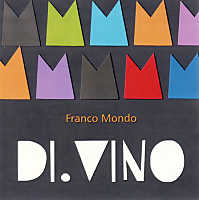
|
|
Monferrato Rosso Di.Vino 2009 |
|
| Franco Mondo (Piedmont, Italy) | |
| Grapes: Barbera (70%), Cabernet Sauvignon (30%) | |
| Price: € 10.00 | Score: |
| Monferrato Rosso Di.Vino shows an intense ruby red color and nuances of ruby red, little transparency. The nose denotes intense, clean, pleasing and refined aromas that start with hints of cherry, plum and black currant followed by aromas of blueberry, violet, pink pepper and vanilla. The mouth has good correspondence to the nose, a slightly tannic attack and however balanced by alcohol, good body, intense flavors, pleasing roundness. The finish is persistent with flavors of cherry, plum and black currant. Monferrato Rosso Di.Vino is made from late harvest grapes and ages for 6 months in cask. | |
| Food Match: Broiled meat and barbecue, Stewed meat, Hard cheese | |
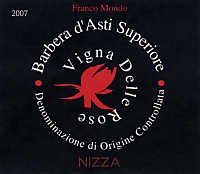
|
|
Barbera d'Asti Superiore Nizza Vigna delle Rose 2007 |
|
| Franco Mondo (Piedmont, Italy) | |
| Grapes: Barbera | |
| Price: € 19.00 | Score: |
| Barbera d'Asti Superiore Nizza Vigna delle Rose shows an intense ruby red color and nuances of garnet red, little transparency. The nose denotes intense, clean, pleasing and refined aromas that start with hints of cherry, plum and violet followed by aromas of blueberry, vanilla, tobacco, cocoa, pink pepper, mace and menthol. The mouth has good correspondence to the nose, a slightly tannic attack and however balanced by alcohol, good body, intense flavors, agreeable. The finish is persistent with flavors of cherry, plum and blueberry. Barbera d'Asti Superiore Nizza Vigna delle Rose ages for 18 months in barrique. | |
| Food Match: Roasted meat, Stewed meat with mushrooms, Hard cheese | |

|
|
Morellino di Scansano Riserva 2008 |
|
| Moris Farms (Tuscany, Italy) | |
| Grapes: Sangiovese (90%), Cabernet Sauvignon, Merlot (10%) | |
| Price: € 18.50 | Score: |
| This Morellino di Scansano Riserva shows a brilliant ruby red color and nuances of garnet red, little transparency. The nose reveals intense, clean, pleasing and refined aromas which start with hints of black cherry, plum and violet followed by aromas of blueberry, black currant, vanilla, tobacco, cocoa, mace and eucalyptus. The mouth has good correspondence to the nose, a tannic attack and however balanced by alcohol, good body, intense flavors, pleasing roundness. The finish is persistent with flavors of black cherry, plum and black currant. Morellino di Scansano Riserva ages for 12 months in barrique followed by 6 months of aging in bottle. | |
| Food Match: Broiled meat and barbecue, Roasted meat, Stewed and braised meat, Hard cheese | |

|
|
Avvoltore 2009 |
|
| Moris Farms (Tuscany, Italy) | |
| Grapes: Sangiovese (75%), Cabernet Sauvignon (20%), Syrah (5%) | |
| Price: € 32.00 | Score: |
| Avvoltore shows an intense ruby red color and nuances of ruby red, little transparency. The nose reveals intense, clean, pleasing, refined and elegant aromas which start with hints of black cherry, plum and violet followed by aromas of black currant, blueberry, raspberry, vanilla, rose, tobacco, chocolate and mace. The mouth has good correspondence to the nose, a tannic attack and however balanced by alcohol, full body, intense flavors, agreeable. The finish is persistent with flavors of black cherry, plum and black currant. Avvoltore ages for 12 months in barrique followed by 6 months of aging in bottle. | |
| Food Match: Game, Roasted meat, Braised and stewed meat, Hard cheese | |
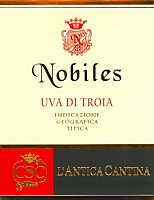
|
|
Daunia Nero di Troia Nobiles 2010 |
|
| Antica Cantina (Apulia, Italy) | |
| Grapes: Uva di Troia | |
| Price: € 4.25 | Score: |
| Daunia Nero di Troia Nobiles shows a brilliant ruby red color and nuances of ruby red, moderate transparency. The nose denotes intense, clean and pleasing aromas that start with hints of plum, blackberry and violet followed by aromas of blueberry, black cherry and carob. The mouth has good correspondence to the nose, a slightly tannic attack and however balanced by alcohol, good body, intense flavors, pleasing roundness. The finish is persistent with flavors of plum, blackberry and black cherry. Daunia Nero di Troia Nobiles ages in steel tanks. | |
| Food Match: Stuffed pasta, Broiled meat and barbecue, Sauteed meat | |
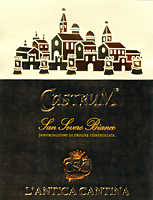
|
|
San Severo Bianco Castrum 2010 |
|
| Antica Cantina (Apulia, Italy) | |
| Grapes: Bombino Bianco (50%), Trebbiano Toscano (40%), Malvasia Bianca (10%) | |
| Price: € 4.35 | Score: |
| San Severo Bianco Castrum shows a pale straw yellow color and nuances of greenish yellow, very transparent. The nose reveals intense, clean, pleasing and refined aromas which start with hints of apple, pear and plum followed by aromas of hawthorn, honey, peach and pineapple. The mouth has good correspondence to the nose, a crisp attack and however balanced by alcohol, good body, intense flavors, pleasing roundness. The finish is persistent with flavors of apple, pear and plum. San Severo Bianco Castrum ages in steel tanks. | |
| Food Match: Pasta and risotto with fish, Vegetable soups, Sauteed fish | |

|
|
Valpolicella Classico Superiore Ripasso Pojega 2009 |
|
| Guerrieri Rizzardi (Veneto, Italy) | |
| Grapes: Corvinone (70%), Corvina (15%), Rondinella, Molinara (15%) | |
| Price: € 9.80 | Score: |
| Valpolicella Classico Superiore Ripasso Pojega shows a brilliant ruby red color and nuances of garnet red, moderate transparency. The nose denotes intense, clean, pleasing and refined aromas which start with hints of plum, blackberry and black cherry followed by aromas of dried violet, raspberry, vanilla and carob. The mouth has good correspondence to the nose, a slightly tannic attack and however balanced by alcohol, good body, intense flavors, pleasing roundness. The finish is persistent with flavors of plum, blackberry and black cherry. Valpolicella Classico Superiore Ripasso Pojega ages in cask for 12 months. | |
| Food Match: Broiled meat and barbecue, Stewed meat, Hard cheese | |
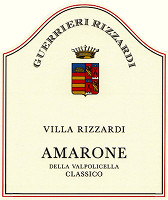
|
|
Amarone della Valpolicella Classico Villa Rizzardi 2006 |
|
| Guerrieri Rizzardi (Veneto, Italy) | |
| Grapes: Corvinone (45%), Corvina (21%), Rondinella (15%), Barbera (11%), Sangiovese (8%) | |
| Price: € 36.50 | Score: |
| Amarone della Valpolicella Classico Villa Rizzardi shows an intense ruby red color and nuances of garnet red, little transparency. The nose reveals intense, clean, pleasing, refined and elegant aromas which start with hints of blackberry, plum and dried violet followed by aromas of blueberry, vanilla, chocolate, cinnamon, tobacco, mace and menthol. The mouth has good correspondence to the nose, a tannic attack and however balanced by alcohol, full body, intense flavors, pleasing roundness. The finish is persistent with flavors of blackberry, plum and black cherry. Amarone della Valpolicella Classico Villa Rizzardi ages for 12 months in barrique and for 24 months in cask. | |
| Food Match: Game, Roasted meat, Braised and stewed meat, Hard cheese | |
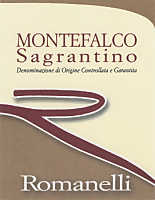
|
|
Montefalco Sagrantino 2008 |
|
| Romanelli (Umbria, Italy) | |
| Grapes: Sagrantino | |
| Price: € 19.00 | Score: |
| This Montefalco Sagrantino shows a brilliant ruby red color and nuances of garnet red, moderate transparency. The nose reveals intense, clean, pleasing, refined and elegant aromas which start with hints of blackberry, plum and violet followed by aromas of black cherry, blueberry, vanilla, tobacco, pink pepper, mace and chocolate. The mouth has good correspondence to the nose, a tannic attack and however balanced by alcohol, full body, intense flavors, pleasing roundness. The finish is persistent with flavors of blackberry, plum and black cherry. This Montefalco Sagrantino ages for 18 months in cask followed by 10 months of aging in bottle. | |
| Food Match: Game, Roasted meat, Stewed and braised meat, Hard cheese | |

|
|
Montefalco Sagrantino Passito 2008 |
|
| Romanelli (Umbria, Italy) | |
| Grapes: Sagrantino | |
| Price: € 18.00 - 375ml | Score: |
| This Montefalco Sagrantino Passito shows an intense ruby red color and nuances of garnet red, little transparency. The nose reveals intense, clean, pleasing, refined and elegant aromas that start with hints of blackberry, black cherry and plum followed by aromas of dried violet, vanilla, chocolate, tobacco, mace, nail polish, mace and menthol. The mouth has good correspondence to the nose, a sweet and tannic attack, however balanced by alcohol, full body, intense flavors, pleasing roundness. The finish is persistent with flavors of blackberry, black cherry and plum. This Montefalco Sagrantino Passito ages for 12 months in barrique followed by at least 6 months of aging in bottle. | |
| Food Match: Wild fruit tarts | |
News |
|
In this section are published news and information about events concerning the world of wine and food. Whoever is interested in publishing this kind of information can send us a mail to our address.
|
AquavitaeReview of Grappa, Distillates and Brandy |
|
|
| Distillates are rated according to DiWineTaste's evaluation method. Please see score legend in the "Wines of the Month" section. |

|
|
Grappa Cuore di Aleatico |
|
| Nannoni (Tuscany, Italy) | |
| Raw matter: Pomace of Aleatico | |
| Price: € 49,00 - 500ml | Score: |
| This grappa is limpid, colorless and crystalline. The nose reveals intense, clean, pleasing and refined aromas of blackberry, plum, dried violet, hazelnut and raspberry, with almost imperceptible alcohol pungency. In the mouth has intense flavors with perceptible alcohol pungency which tends to dissolve rapidly, good correspondence to the nose, pleasing roundness, balanced. The finish is persistent with flavors of blackberry, plum and raspberry. This grappa is distilled in a batch steam operated alembic still. Alcohol 42%. | |
Wine Parade |
|
|
| The best 15 wines according to DiWineTaste's readers. To express your best three wines send us an E-mail or fill in the form available at our WEB site. |
| Rank | Wine, Producer | |
|---|---|---|
| 1 |
| Barolo Cannubi Boschis 2005, Sandrone (Italy) |
| 2 |
| Brunello di Montalcino 2006, Siro Pacenti (Italy) |
| 3 |
| Brunello di Montalcino Vigneto Manachiara 2005, Tenute Silvio Nardi (Italy) |
| 4 |
| Rosso Conero Riserva Grosso Agontano 2007, Garofoli (Italy) |
| 5 |
| Batàr 2008, Querciabella (Italy) |
| 6 |
| Arkezia Muffo di San Sisto 2004, Fazi Battaglia (Italy) |
| 7 |
| Collio Sauvignon Ronco delle Mele 2010, Venica (Italy) |
| 8 |
| Gran Masetto 2007, Endrizzi (Italy) |
| 9 |
| Confini 2007, Lis Neris (Italy) |
| 10 |
| Franciacorta Pas Dosé Récemment Dégorgé 2006, Cavalleri (Italy) |
| 11 |
| Adarmando 2009, Tabarrini (Italy) |
| 12 |
| Trento Brut Riserva Methius 2004, Dorigati (Italy) |
| 13 |
| Aglianico del Vulture Il Repertorio 2006, Cantine del Notaio (Italy) |
| 14 |
| Sagrantino di Montefalco Collepiano 2007, Arnaldo Caprai (Italy) |
| 15 |
| Soave Motto Piane 2008, Fattori (Italy) |
| |||||||
Privacy Policy | |||||||


| Copyright © 2002-2024 Antonello Biancalana, DiWineTaste - All rights reserved |
| All rights reserved under international copyright conventions. No part of this publication and of this WEB site may be
reproduced or utilized in any form or by any means, electronic or mechanical, without permission in writing from DiWineTaste. |